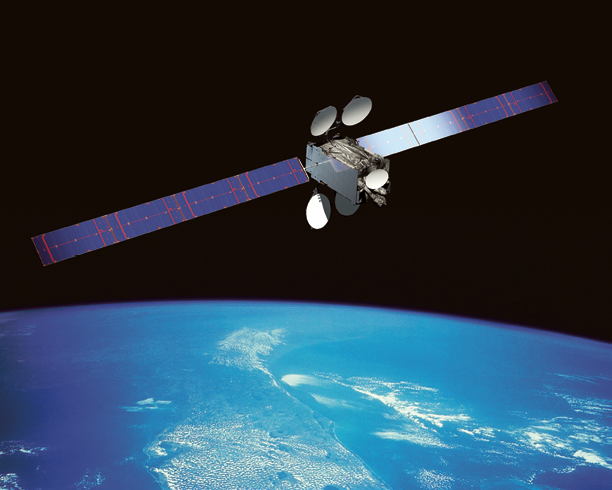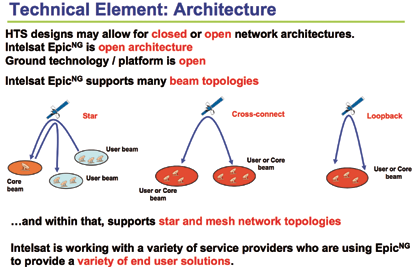The new high throughput satellite (HTS) systems that have been announced or deployed have created great anticipation among satellite customers for major performance improvements.

While the messaging has often focused on a satellite’s aggregate gigabits per second (Gbps), there is more to these HTS systems than raw capacity. Customers also need to examine the architectures underlying the service offerings to ensure they match their specific communication needs. This architectural review should include the topologies, ground technologies, and service level agreements (SLAs) supported.
HTS satellites are indeed throughput game changers, positioning large amounts of capacity in space at only an incremental cost increase over widebeam satellites. Both Ku- and Ka-band HTS systems offer these significant increases in Gbps per satellite.
HTS satellites do this by using small spot beams, which improve bits/Hertz efficiency, and a high factor of frequency re-use, which increases the aggregate amount of Hertz. This is a win-win for satellite operators and their customers.
Beyond this, customers need to understand how those Gbps can be accessed and utilized. A critical question to answer is whether an HTS offering is ‘open’ or ‘closed.’ Each type has common characteristics in terms of topologies, technologies and services supported.

Artistic rendition of the Intelsat 29e, the first of the company’s Intelsat EpicNG satellites. Image is courtesy of Intelsat.
Closed HTS architectures include ViaSat, Inmarsat Global Xpress, Hughes Network Systems Jupiter, and Eutelsat KA-SAT.
Open HTS architectures include Intelsat EpicNG, Telesat VANTAGE and Inmarsat High Capacity Overlay (HCO).
A closed HTS architecture requires a star topology. This means all remote terminal traffic must route via one of a limited number of gateways or access stations. This is similar to commercial airline travel, where one must travel through an airline’s hub to reach a certain city even if that is not the shortest distance to your final destination. Closed architectures do not allow loopback within a satellite beam or customer beam-to-customer beam topologies.
Open architectures, such as Intelsat EpicNG™, support multiple connection topologies. Traffic from a user beam can be routed loopback to the same user beam, cross-connect to another user beam, or reach back to a core beam..
Inmarsat HCO supports loopback and reach-back topologies. Within these beam connections, both star and mesh traffic topologies are supported. Please see below figure.
On the ground, closed architecture HTS systems require that all terminals use common equipment. Each closed HTS service is based upon a single platform and all terminals must use that platform.
Open HTS systems differentiate themselves by allowing users to select their preferred ground equipment, be that an installed base or a newly selected deployment. The ability to use existing ground equipment in open systems can lead to substantial cost savings for the customer.
These ground equipment differences also influence what service level agreements can be supported. Closed architecture HTS are shared services. Terminals from multiple independent users, or user groups, share a common pool of satellite resources. Those same terminals however, demand throughput in their own, independent, ways.

As such, closed HTS services have to limit what can be guaranteed. Limits may include no guarantee of achieving the maximum throughput (it is best effort) or no guarantee of the availability of a circuit (e.g., a voice line or a 512 kbps duplex link).
In open HTS architectures, users can purchase dedicated capacity for their terminal or group of terminals. The throughput of that capacity is dedicated and available to only the user’s terminals. As such, maximum throughput capabilities can be guaranteed.
This is analogous to residential versus enterprise terrestrial broadband service. With a residential cable connection, a group of houses share one hub and its bandwidth.
Throughput to a specific house is dependent upon how heavily the other houses are using the shared connection. The open alternative is analogous to enterprise broadband which is provided via a direct connection, not shared, and can guarantee throughput levels.
In summary, customers evaluating HTS options should understand not only a system’s capacity but also how those Gbps can be used to meet specific needs. Here’s a list of potential questions to consider:
• To where must the remote terminals connect? In theater? Reach back? Both?
• Can the HTS provide all required connectivities in a single satellite hop?
• What ground hardware must be used to access the HTS?
• Is the ground hardware appropriate for the needs?
• Can existing assets be leveraged or will new investment be required?
• Can the HTS Gbps be purchased and utilized in a manner that provides the guaranteed throughputs and availabilities required by the mission?
For those interested in maximum flexibility in connectivities, ground equipment and SLAs, open systems such as Intelsat EpicNG truly deliver the solutions in a most complimentary manner.
Editor’s Note: Our thanks to Intelsat General for allowing us to republish this article from their SatCom Frontier blog.

